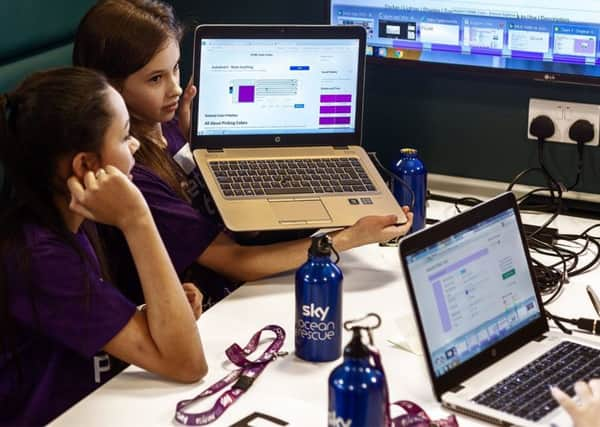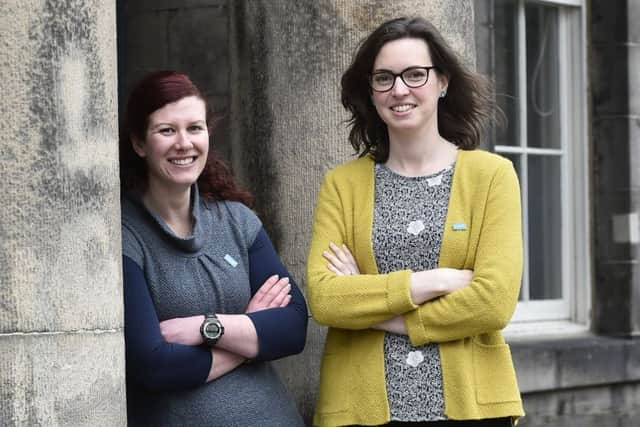Insight: Role models blaze trail for female STEM students in Scotland


Hannah Houston was on board a Boeing 787 Dreamliner on a family holiday to Florida when she experienced something of an epiphany. “It was a brand new aeroplane and I remember thinking: ‘This is so cool.’ I was about 16 and didn’t understand what it meant in terms of my future career. I just knew I was really excited to be there.”
Now in the fourth year of a degree in mechanical engineering at Strathclyde University, Houston had always excelled at maths and physics. But, like many smart girls, she had assumed she would end up in a more typically “female” job, like medicine or dentistry.
Advertisement
Hide AdAdvertisement
Hide Ad“Throughout my early life, I was affected by gender stereotypes that were pushed on me,” she says. “In my mind, engineering was a man’s job so I never considered it. But then, in sixth year, I told my physics teacher how much I liked planes and he said: ‘Well, that’s engineering.’


“I think he was quite surprised, but at the same time, he knew I was headstrong and that I would be able to do anything I set my mind to. It must have been a bit of a learning curve for him, too, because, although he encouraged me from then on, he had never thought to suggest it to me.”
Embarking on her degree (which, as it turns out, does not involve planes), Houston found she was in the minority. Just 10 per cent of her course are female, but she was lucky because Strathclyde University had a system of pairing up women so she didn’t feel too isolated and was able to build up a female network.
“I have never felt discriminated against,” she says. “Everyone I study with treats me as an engineer first and a woman second. That’s very important to me.”
It is also important to Houston that more women follow in her footsteps. To that end she is one of 12 student champions with Equate Scotland, an organisation set up to encourage more women to study Science, Technology, Engineering and Maths (STEM) subjects and to support those who do so they go on to forge careers within those fields. Last week, at Equate Scotland’s Student Network Conference, Houston was named Woman Student of the Year for her evangelism and commitment to the cause.


To understand how vital such campaigning is, we could start by looking at the statistics. According to the First Minister’s National Advisory Council on Women and Girls, female students account for 66 per cent of Higher biology entries, 53 per cent of chemistry entries, 48 per cent of maths entries, 28 per cent of physics entries, 16 per cent of computing science entries and just 10 per cent of engineering science entries.
Sixteen per cent of those opting for engineering and technology in higher education are women, compared with 62 per cent for medicine and dentistry and 83 per cent for veterinary science.
Meanwhile, women accounted for just 3 per cent of those who started a modern apprenticeship in construction in the first quarter of 2018/19, while all 60 engineering and energy-related apprenticeships in the same period were taken up by men.
Advertisement
Hide AdAdvertisement
Hide AdEvery university and college in Scotland has a target of achieving 25 per cent of an under-represented gender on any course by 2030; that means trying to encourage men into nursing as well as women into STEM subjects.
As far as STEM is concerned, things are beginning to change. Houston says the proportion of women in this year’s intake on her course rose to 30 per cent. But progress is slow. A report by the Royal Society of Edinburgh found that – despite all the efforts – the total number of women studying for engineering and technology degrees has only increased by 5 per cent since 2012. The same report suggested there had been a mere 3 per cent rise in the number of women with a STEM qualification who stay in the sector long-term. That figure now stands at 30 per cent.
So why is gender balance significant? “It’s about women’s fulfilment because they are ambitious and intelligent and interested enough to pursue these subjects,” says Talat Yaqoob, Equate Scotland’s director. “But it’s also about the future. We already have a skill shortage for STEM jobs in Scotland. These sectors aren’t going to last or be globally competitive if half the population is being isolated.
“Thirdly, most of the jobs of the future are going to be in STEM, so if we don’t do something to address the imbalance, we will further exacerbate the issue of women’s inequality. We will make the gender pay gap wider and occupational segregation worse because non-STEM jobs, like front of house and retail, which women often do, are disappearing.”
Another pressing societal reason for increasing the number of women in senior STEM roles is evidenced by Caroline Criado-Perez’s new feminist Bible, Invisible Women: Exposing Data Bias In A World Designed For Men.
Criado-Perez shows us how a field dominated by men inevitably produces technology unfit for women. Some of the examples she cites are mind-boggling. When a woman is in a car crash, she is 47 per cent more likely to be seriously injured than a man, and 17 per cent more likely to die because cars have been designed using crash dummies based on the “average male”; Google speech recognition software is up to 70 per cent more likely to recognise male speech; the average smart phone size is 5.5 inches – not much smaller than the average woman’s hand.
Houston has an example of her own. “When Apple first designed its health app for the iPhone it recorded different health statistics. There were statistics to monitor diabetes and epilepsy,” she says. “But the app was designed by men and they didn’t think to cover reproductive health, something that affects more than 50 per cent of the population.
“I think that goes to show it’s important to have a diversity of ideas and to involve as many people as possible. You need to get all points of view, not only in terms of gender, but in terms of race, sexuality and disability. It’s about trying to understand what everyone needs and levelling the playing field a bit.”
Advertisement
Hide AdAdvertisement
Hide AdGender imbalance in STEM starts at school. In a world where toys are gendered and T-shirts come with “Born To Lead” messages for boys and “Daddy’s Little Princess” slogans for girls, pupils unconsciously absorb messages about their roles and gravitate towards the professions that they have been taught to see as gender-appropriate.
In the past few years, some pioneering individuals and organisations have committed themselves to redressing the balance.
Take Toni Scullion. She is a computing science teacher at St Kentigern’s Academy in Blackburn, West Lothian. Though she was one of the few girls who studied the subject, she never considered it a sphere from which she might be excluded, nor did she notice any bias when she started teaching. “I think I was really naive about the gender gap,” she says.
It was only when her attention was drawn to Insight – a Scottish government benchmarking tool, which charts the number of pupils per school studying the subject at National 5, Higher and Advanced Higher – that she realised St Kentigern’s was bucking the national trend.
“It suddenly struck me that we were doing particularly well in terms of the number of girls [picking the subject]. We are far from 50:50 – I think we are somewhere around 23 per cent at National 5 – but what makes us different is that we keep that 20-odd per cent through Higher and Advanced Higher.” Nationally, she says, the percentage of girls taking computing science at Higher and Advanced Higher drops to as low as 6 per cent in some places. The number of boys taking Advanced Higher computing science last year was 480; the number of girls, just 68.
“Sixty-eight girls: that’s all we can inspire? It baffles me,” says Scullion. “I began to feel really angry and I took that rage and decided to do something about it.”
Early in her teaching career, Scullion launched a lunchtime coding club for her pupils. Soon, however, she noticed girls were more likely to drop out after a few sessions. When she asked them why, they said: “The boys are too loud. There aren’t enough girls. I don’t have any friends.” So she set up a separate club for girls and they started coming in greater numbers. Now she continues to run separate clubs for boys and girls, but also a “free-for-all” club on a Thursday. “It’s nice because the girls now attend the free-for-all – I think it’s just about gaining confidence. They think: ‘I can do this.’”
Scullion also appointed three senior girls as Turing’s Testers, the name inspired by the women in computing science during the Second World War who didn’t get individual recognition. These girls, who have been going to the coding clubs since first year, mentor the younger ones.
Advertisement
Hide AdAdvertisement
Hide AdOn a roll, she went on to set up a charity called Dresscode, which is sponsored by JP Morgan. This involved creating a package of resources so other teachers could set up coding clubs. Dresscode will be rolled out to all secondary schools in Scotland in August.
On International Women’s Day, she also ran her first hackathon, with 50 S1 girls from four schools and 13 senior pupil mentors, at the Scottish head office of Sky in Livingston.
JP Morgan has now given Dresscode money for hackathons across the country. “I want to find local tech companies to run hackathons, partly to bridge the gap between education and industry and also so pupils can see you don’t need to move to London or abroad; you can stay in Scotland and work in a massive tech company and make a difference.”
Unfortunately, attracting girls to study STEM subjects is only half the battle. Once they are there, support is required to make sure they do not drop out; and then again to ensure they find jobs and stay in the industry.
Equate Scotland, and its 12 student champions, work with universities to establish female networks and to highlight the subtler ways in which sexism sometimes manifests itself.
“When you ask the student champions, most of them will say they haven’t experienced overt sexism, but then you scratch beneath the surface and they say: ‘Well, I was recommended to do a female dominated course,’ or ‘people still ask if I really want to do this’ or ‘I get talked over in class’ or ‘my reading list is all male and when I point it out everybody rolls their eyes’, and they start to understand how much is going on around them in terms of socialised, institutionalised sexism,” says Yaqoob.
Equate Scotland still faces a degree of scepticism when it talks about women-only spaces and positive action measures. “I think a lot of work needs to be done to explain or combat some of the misconceptions around what positive action measures are because people will say ‘well, that’s discrimination’,” says Yaqoob. “But we are just trying to get everybody to start from the same point in the race and to erase some of the barriers.”
One positive measure proving successful is Equate Scotland’s female-only Careerwise Placement scheme. For the past six years, the organisation has approached employers and asked them if they would be interested in taking on a female intern for 12 weeks on a living wage. The interested companies put together an advert which is distributed across university and campuses. Then the companies pick the best candidate from the resulting applications. Last year, there were 500 applications for 60 placements. Though the female retention rate across STEM is 30 per cent, the rate for women who have taken part in a Careerwise placement is said to be 60 per cent.
Advertisement
Hide AdAdvertisement
Hide AdAnother Equate Scotland initiative is the recently instituted career hub – a recruitment platform for companies who want to demonstrate that they are proactively interested in hiring women. Companies that sign up will place adverts for jobs (open to both sexes) on several sites, including the career hub, which is accessed by female candidates. Equate Scotland will scrutinise the adverts for language known to put women off applying.
“A while ago I was on a well-known job website and I put in the words ‘technology’ and ‘aggressive’ and it came up with 9,000 jobs,” says Yaqoob. “Companies would use the phrase ‘aggressively competitive’ or ‘aggressive strategy’. Another common term within computing is ‘coding ninjas’. Those phrases come with so many connotations – why would you use them?”
Equate Scotland has already broken its target for firms advertising on the Career Hub, with giants like Rockstar North (gender pay gap 64 per cent), Barclays and Diageo getting involved.
“We are attracting big companies, but also SMEs and start-ups who want to get off on the right foot,” says Yaqoob.
Equate Scotland is not the only organisation helping women develop the skills and the confidence they need to rise to the top in STEM careers.
The Royal Society of Edinburgh is holding a Celebrating Women in Science in Scotland exhibition in an attempt to raise the profile of female role models.
The women featured were photographed with an object which illustrated either the inspiration for their career choice or their scientific journey. Professor Dame Anne Glover, special adviser to the principal at Strathclyde University, chose a lego model of female scientists in a lab; Professor Lesley Yellowlees, professor emerita in inorganic electrochemistry at Edinburgh University chose a dye sensitised solar cell.
And at Equate’s Student Network Conference, the keynote speakers were Kirsty Robb and Helen Wade, who earlier this year took part in an all-female expedition to Antarctica through an initiative called Homeward Bound. The project has been set up to heighten the impact and influence of women in making decisions that change the planet, moulding them into potential leaders.
Advertisement
Hide AdAdvertisement
Hide AdRobb, a biochemist and post-doctoral researcher currently working on a project to fight antimicrobial resistance, still smarts when she remembers the male chemistry teacher who slammed her test paper down on the table and told her she would never be any good. She left school at 17, but later worked her way up from a HNC to a PhD. Wade’s first degree was in English, but she found herself drawn to nature and now works as a marine ornithologist with Scottish Natural Heritage.
She made the shift from academia to SNH because she felt the short-term contracts and frequent moves of academia might be incompatible with starting a family.
Both say the Homeward Bound project – which involved a lot of pre-trip personal development work – helped them to believe in their own abilities. “I have had imposter syndrome my whole life,” says Robb. “Now I have more confidence and a better understanding of myself. Sometimes, I will still think ‘Oh, no – I am not qualified for this,’ but then I’ll take a step back and realise I am.”
Although things are improving, they agree progress is not happening fast enough. Only one of the six professors in Robb’s department at Strathclyde University is a woman. Last week the first all-women Nasa space walk had to be turned into a one-man, one-woman space walk because there was only one medium-sized space suit available.
If last week’s conference is anything to go by, however, the current generation of female STEM students and workers are determined to change the world.
Robb says she loves doing public engagement and schools outreach. Fai Johnson, another Equate Scotland student champion, is in her third year of a biomedical engineering degree at Glasgow University. “I want to be a role model for others because when I was at school age, I didn’t know any women in engineering. I want to fill that void,” she says.
As for Houston, she fizzes with so much energy she seems capable of single-handedly crushing the patriarchy.
“I want to look forward to getting out of bed in the morning and going into work and solving problems,” she says. “To letting my career take me wherever I want to go. There’s something about being so excited about my future as an engineer that makes me feel unstoppable.”